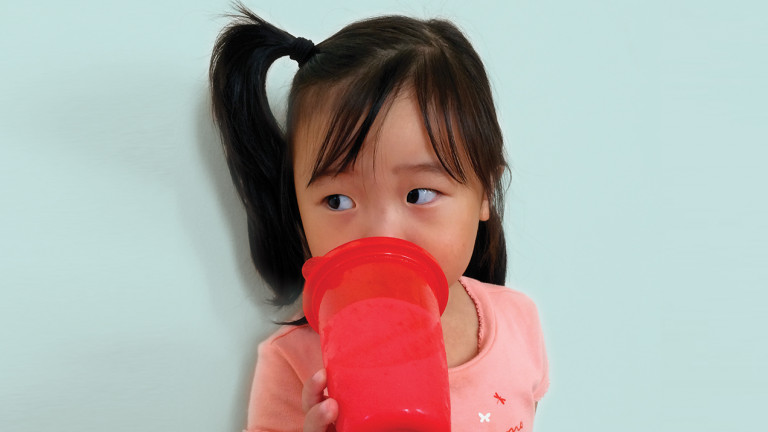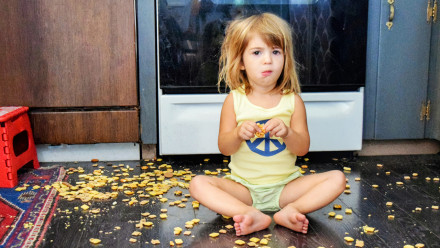Sippy cups are ubiquitous in toddlerhood. But should they be?

Photo:@moricat via Instagram
Kristi Vimy, a busy mom of three kids under seven, often serves water in sippy cups between meals and when the family is on the go, and uses them for milk at meals for her toddler. “They prevent a mess—I love that I can fill them up and pack them in a bag without worrying about spills,” she says. But Vimy has recently heard some negative things from mom friends, and on parenting blogs, about sippies: that they can cause delays in the proper formation of mouth muscles, leading to speech delays, and that there can be nutritional and dental issues when you overuse them. Although I, too, sometimes use sippy cups when on the go with my preschooler and toddler, as a dietitian, I share Vimy’s concerns. Sippy cups—although convenient—have their downsides.
“Sippy cups are not the best choice for kids, because they prevent the opportunity to practise mature oral motor and swallowing skills,” says Melissa Wilson, a Calgary paediatric occupational therapist. She explains that children use an immature, infant-like sucking motion when drinking from a sippy cup, and the spout prevents the front of the tongue from elevating during swallowing. Using sippy cups multiple times a day and for an extended period of time can prevent a child from developing the independent lip, jaw and tongue movements needed for successfully drinking from a regular open cup at an appropriate age (around one year). What’s more, the spout of most sippy cups is similar to a baby’s bottle and can easily become a pacifier or source of comfort for a toddler. “They are glorified bottles,” says Wilson.
The most recent Canadian infant-feeding guidelines say regular open cups are the best choice for kids six months and up. Most parents don’t realize that as soon as a baby starts solids, she can begin using a regular cup for water or even small amounts of breastmilk with help from Mom or Dad. Personally, I found that introducing an open cup at six months helped my daughter “get it” sooner. Now almost two, she uses a regular cup on her own without many spills.
 What to do when your toddler won’t eat anything but snacks’Becky Blair, a dietitian in Barrie, Ont., who helped develop the new national infant-feeding guidelines, shares my main concern with sippy cups, which is that they often serve as a vehicle for sugary drinks such as juice, formula or milk. When toddlers sip frequently throughout the day (which they will if there’s a sippy cup hanging around), they’re exposed to excess calories and sugar, which can lead to unhealthy weight gain and health issues down the road, not to mention an increased risk of cavities. Dina Kulik, a Toronto paediatrician, worries most about babies and toddlers who are sent to bed with a sippy full of milk or juice. “Kids should never sleep with bottles or sippy cups, as the sugar in milk will sit on the teeth all night, putting a child at risk for cavities.”
What to do when your toddler won’t eat anything but snacks’Becky Blair, a dietitian in Barrie, Ont., who helped develop the new national infant-feeding guidelines, shares my main concern with sippy cups, which is that they often serve as a vehicle for sugary drinks such as juice, formula or milk. When toddlers sip frequently throughout the day (which they will if there’s a sippy cup hanging around), they’re exposed to excess calories and sugar, which can lead to unhealthy weight gain and health issues down the road, not to mention an increased risk of cavities. Dina Kulik, a Toronto paediatrician, worries most about babies and toddlers who are sent to bed with a sippy full of milk or juice. “Kids should never sleep with bottles or sippy cups, as the sugar in milk will sit on the teeth all night, putting a child at risk for cavities.”
With a regular cup, which you’ll need to serve at the table or in a high chair, you’ll be able to keep a closer eye on how much your baby or toddler is consuming. For on-the-go drinking, Wilson suggests using a portable straw cup. “Straw drinking allows the tip of a toddler’s tongue to elevate during a swallow and the toddler to use their lips, tongue and jaw more independently.” Good old water bottles can work well too, although these are harder to master at a young age.
As for Vimy, she’s making an effort to serve her kids drinks in regular cups more often and to use straw cups when she needs the convenience—although she still uses sippy cups on occasion to prevent spills. I do too, and that’s OK. If you have a two- or three-year-old who is still slurping exclusively from sippies, don’t beat yourself up about it. Just start introducing a regular cup at meal and snack times (your tot will need your help at first) and be patient—but you may be surprised at how quickly your little one catches on to a regular cup.
Expert Tip To help your baby or toddler learn how to use an open cup, Melissa Wilson, a paediatric occupational therapist in Calgary, suggests starting one sip at a time with a small medi-cup (like the one that comes on top of a Tylenol bottle) and having an adult hold it, or trying an open “trainer” cup, such as Avent’s Natural Drinking Cup or Munchkin’s Miracle 360˚ Trainer Cup.
Read more: Why does my toddler drink dirty bathwater? 14 inventive products for starting solids with your baby
FILED UNDER: Kids health Steps and Stages Toddler Toddler development Toddlers
Source link : https://www.todaysparent.com/toddler/should-your-toddler-use-a-sippy-cup












